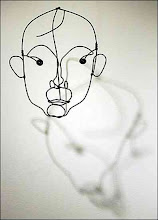...wondering whether the brain's (or should I say the mind's?) power to create anosognosia is related in any way to its creative powers, to the relative strength of different minds to create convincing alternative (literary) worlds? Is more anosognosia at display in a poet whose interests lie mainly in interiority (the personal, confession, the lyrical self) or in a poet whose interests lie mainly in exteriority (objects, the external world, actuality)? Which ignores more?
Also wondering whether anosognosia and other similar disruptions are merely errors of thought without physical manifestations (that is, there's nothing wrong with the brain, just with the ideas it's processing). Are they high-level errors without low-level (mechanical) problems. This is not only a "who's pushing whom around in there?" question, it's also an assumption (that there are such errors of thought or processing) that provides the entire basis of psychoanalysis. Ramachandran's work with phantom limbs certainly seems to support the idea that some problems are in the ideas of which the mind has convinced itself and stored away and that those ideas can be "cured".
And what about language here? How much of the self/not-self disconnect is complicated by the subject's use of language and the attachment of language to a sense of self? The attachment of language to body parts?
Subscribe to:
Post Comments (Atom)




No comments:
Post a Comment